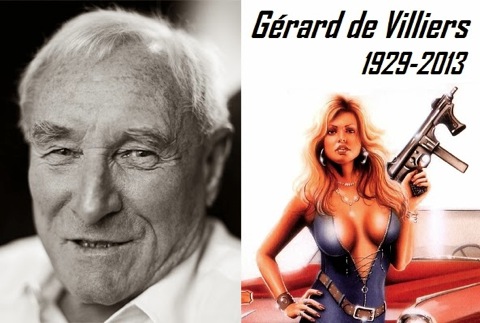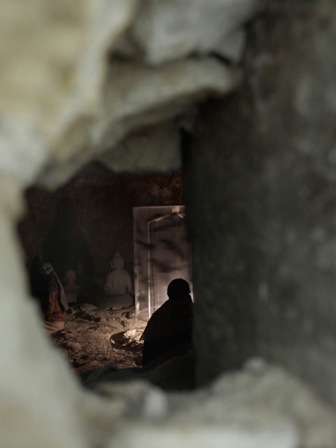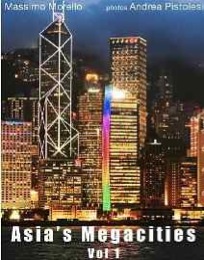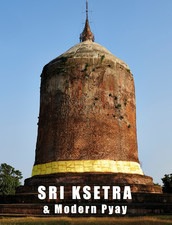Stories
Spies, Spooks and Stories
14/11/13 05:22
Gérard de Villiers, "the spy novelist who knows too much", has died. He is someone who, in one way or another, has been my travel companion in many parts of the world. To him, and to another old friend of mine, I dedicate a short story that can only be published HERE , on Bassifondi.


0 Comments
Time Being
23/10/13 12:06
The house cat is called Schrödinger. He is the key to everything. In the sense that he can be a being and a non-being at the same time. The cat's name recalls the paradox of physician Erwin Schrödinger, one of those mental quantum mechanics experiments that are as fascinating as they incomprehensible.
Schrödinger is a character in A Tale for the Time Being, the latest novel by Ruth Ozeki.

“A time being is someone who lives in time, and that means you, and me, and every one of us who is, or was, or ever will be,” writes the author and Zen monk in the first few lines. This too can sound like a quantic affirmation: time can be experienced only as a series of interdependent relationships. This thesis was made approximately eight hundred years ago by Dogen Zenji (1200-1253), one of Japan's greatest thinkers and masters of Zen Buddhism, in his essay Time Being. Ozeki is on the record as saying this man was an inspiration for her novel.
From that point of view, the book might look like just another post-new-age story. But in fact - as its appearance on the prestigious Man Booker Prize 2013 shortlist indicates - it is a complex novel, weaving together mystery and meditation, history and record, different space-time levels.
It is brilliant, in my opinion.
But, aside from my opinion, it can be said to be about various subjects. About writing as a “form of prayer”. “You’re not praying to a god, but you’re almost conjuring a reader to arrive,” says Ozeki, comparing writers to people who “hear voices”. “People have always heard voices. Sometimes they’re called shamans, sometimes they’re called mad, and sometimes they’re called fiction writers.”
Schrödinger, the physician and the cat, the monk, the shaman, the writer and all the characters in this novel demonstrate, in turn, how philosophical novels can be written. Which has been and is still called into question by many. According to a very Western, limited vision, they belong to two different worlds, they require different ways of thinking and writing.
A Tale for the Time Being, then, is just another work in the great search for truth, the latest in the eternal struggle between art and philosophy.
The tale, the “récit” on Les Aventures de la vérité, is still on show at the Fondation Maeght in Saint Paul-de Vence, France. Curated by Bernard-Henri Lévy, it attempts to show, as the philosopher-adventurer wrote, “the slightly crazy project of telling and interweaving the history of philosophy and painting”. What he says about painting can also be applied to literature: “I really believe that its first vocation, its primary role, is to think, and to make us think, about the world.”
 “Caverne de Platon”, by Huang Yong Ping, from “Les Aventures de la Vérité”
“Caverne de Platon”, by Huang Yong Ping, from “Les Aventures de la Vérité”
All of this cannot be easy, as the prophets of uncultured thinking would have us believe. Once again the key to everything is Schrödinger's cat. You have to choose whether to live in a box and stay trapped in the paradox for ever, or to open the box. To begin with, we will open the Hello Kitty lunchbox that contains the tale of the time being.
Schrödinger is a character in A Tale for the Time Being, the latest novel by Ruth Ozeki.

“A time being is someone who lives in time, and that means you, and me, and every one of us who is, or was, or ever will be,” writes the author and Zen monk in the first few lines. This too can sound like a quantic affirmation: time can be experienced only as a series of interdependent relationships. This thesis was made approximately eight hundred years ago by Dogen Zenji (1200-1253), one of Japan's greatest thinkers and masters of Zen Buddhism, in his essay Time Being. Ozeki is on the record as saying this man was an inspiration for her novel.
From that point of view, the book might look like just another post-new-age story. But in fact - as its appearance on the prestigious Man Booker Prize 2013 shortlist indicates - it is a complex novel, weaving together mystery and meditation, history and record, different space-time levels.
It is brilliant, in my opinion.
But, aside from my opinion, it can be said to be about various subjects. About writing as a “form of prayer”. “You’re not praying to a god, but you’re almost conjuring a reader to arrive,” says Ozeki, comparing writers to people who “hear voices”. “People have always heard voices. Sometimes they’re called shamans, sometimes they’re called mad, and sometimes they’re called fiction writers.”
Schrödinger, the physician and the cat, the monk, the shaman, the writer and all the characters in this novel demonstrate, in turn, how philosophical novels can be written. Which has been and is still called into question by many. According to a very Western, limited vision, they belong to two different worlds, they require different ways of thinking and writing.
A Tale for the Time Being, then, is just another work in the great search for truth, the latest in the eternal struggle between art and philosophy.
The tale, the “récit” on Les Aventures de la vérité, is still on show at the Fondation Maeght in Saint Paul-de Vence, France. Curated by Bernard-Henri Lévy, it attempts to show, as the philosopher-adventurer wrote, “the slightly crazy project of telling and interweaving the history of philosophy and painting”. What he says about painting can also be applied to literature: “I really believe that its first vocation, its primary role, is to think, and to make us think, about the world.”
 “Caverne de Platon”, by Huang Yong Ping, from “Les Aventures de la Vérité”
“Caverne de Platon”, by Huang Yong Ping, from “Les Aventures de la Vérité”All of this cannot be easy, as the prophets of uncultured thinking would have us believe. Once again the key to everything is Schrödinger's cat. You have to choose whether to live in a box and stay trapped in the paradox for ever, or to open the box. To begin with, we will open the Hello Kitty lunchbox that contains the tale of the time being.
A Tale for the Time Being by Ruth Ozeki -- Official Book Trailer from Viking Books on Vimeo.
Panda help me
27/06/12 20:20
A story of Chinese boxes. We would need to search through the boxes and then put together what we have found. You might end up with a great story on Asia. About the past and the future. The present, as we know, doesn’t exist, and it's even more fluid in Asia.
For now – but which now? – you can find traces of it in Stories: The dragon Lady, the Taoist and other demons.
For the future, who knows? I would like to return to Kep, and I have to go to Phnom Penh for the Asean summit. As for Chongqing there is a new Air Asia flight from Bangkok and I might take the chance to visit the city zoo.
If nothing else, I can see the pandas. And, you know, everybody loves pandas.

For now – but which now? – you can find traces of it in Stories: The dragon Lady, the Taoist and other demons.
For the future, who knows? I would like to return to Kep, and I have to go to Phnom Penh for the Asean summit. As for Chongqing there is a new Air Asia flight from Bangkok and I might take the chance to visit the city zoo.
If nothing else, I can see the pandas. And, you know, everybody loves pandas.

Death Elsewhere
22/06/12 11:42
Vacation, Elsewhere. Two words expressing two myths. Often bindingly linked. The vacation is elsewhere. The elsewhere is a vacation, in that it is a place where we can unplug (or at least we think we can) from our thoughts, anxieties and day-to-day problems. One of these words, however, takes on an unsettling meaning, especially in Italian culture. And that is Elsewhere. It’s a place where everything is different, unknown, potentially hostile, where even the food can be a source of hidden danger. That is when a vacation elsewhere can change from a dream to a nightmare. To say nothing of when the elsewhere becomes the scene of a crime.
This is the meaning of the text published in the Stories section. Entitled Death in Remote Places, it is taken from a recently released book, Faking It in Bangkok, which draws together articles and blog posts by Christopher G. Moore, a Canadian writer living in Thailand since 1988, known mainly for his short stories and novels in the crime and noir genre, set in South-East Asia.
That (or this, for Moore and for others writing about it) is the overriding image of Elsewhere, with all of its real or presumed human, natural and cultural exoticisms. There (or here), every plot is packed with mystery and, to use another platitude, reality becomes fiction. This generates a paradoxical morbid fascination, further feeding the myth of Elsewhere. In a, literally, vicious circle.
In the meantime, to confirm what Moore writes, and worthy of one of his thrillers, we have the case of the two Canadian sisters recently found dead in their hotel room on Phi Phi Island, one of those places symbolic of exotic vacations, and also the location for the Leonardo Di Caprio film, The Beach (which also relates the tale of a dream vacation going horribly wrong).
The two sisters showed no signs of violence and do not appear to have been the victims of crime. Initial reports indicate they may have died from food poisoning, but the causes are yet to be clarified. The very similar deaths of two other female tourists, an American and a Norwegian, on the same island in 2009 remain unresolved to this day. Assisting with the investigation is Dr Pornthip Rojanasunand, director of the Thai forensic pathology institute, the Asian incarnation of Kay Scarpetta, created by thriller author Patricia Cornwell. Far from being reassuring, this sends a few shivers down the spine. Which, in this heat, is not unwelcome.
 Et in Arcadia ego, a painting by Guercino (1591-1668). The inscription at the bottom of the painting can be literally translated "Even in Arcadia I”. Open to interpretation, in this case it reminds us of the omnipresence of death in space and time. At all times and everywhere, even in utopian places such as Arcadia.
Et in Arcadia ego, a painting by Guercino (1591-1668). The inscription at the bottom of the painting can be literally translated "Even in Arcadia I”. Open to interpretation, in this case it reminds us of the omnipresence of death in space and time. At all times and everywhere, even in utopian places such as Arcadia.
This is the meaning of the text published in the Stories section. Entitled Death in Remote Places, it is taken from a recently released book, Faking It in Bangkok, which draws together articles and blog posts by Christopher G. Moore, a Canadian writer living in Thailand since 1988, known mainly for his short stories and novels in the crime and noir genre, set in South-East Asia.
That (or this, for Moore and for others writing about it) is the overriding image of Elsewhere, with all of its real or presumed human, natural and cultural exoticisms. There (or here), every plot is packed with mystery and, to use another platitude, reality becomes fiction. This generates a paradoxical morbid fascination, further feeding the myth of Elsewhere. In a, literally, vicious circle.
In the meantime, to confirm what Moore writes, and worthy of one of his thrillers, we have the case of the two Canadian sisters recently found dead in their hotel room on Phi Phi Island, one of those places symbolic of exotic vacations, and also the location for the Leonardo Di Caprio film, The Beach (which also relates the tale of a dream vacation going horribly wrong).
The two sisters showed no signs of violence and do not appear to have been the victims of crime. Initial reports indicate they may have died from food poisoning, but the causes are yet to be clarified. The very similar deaths of two other female tourists, an American and a Norwegian, on the same island in 2009 remain unresolved to this day. Assisting with the investigation is Dr Pornthip Rojanasunand, director of the Thai forensic pathology institute, the Asian incarnation of Kay Scarpetta, created by thriller author Patricia Cornwell. Far from being reassuring, this sends a few shivers down the spine. Which, in this heat, is not unwelcome.
 Et in Arcadia ego, a painting by Guercino (1591-1668). The inscription at the bottom of the painting can be literally translated "Even in Arcadia I”. Open to interpretation, in this case it reminds us of the omnipresence of death in space and time. At all times and everywhere, even in utopian places such as Arcadia.
Et in Arcadia ego, a painting by Guercino (1591-1668). The inscription at the bottom of the painting can be literally translated "Even in Arcadia I”. Open to interpretation, in this case it reminds us of the omnipresence of death in space and time. At all times and everywhere, even in utopian places such as Arcadia.On the Razor's Edge
19/05/12 04:48
“The sharp edge of a razor is difficult to pass over; thus the wise say the path to Salvation is hard”. This is an extract from the Katha Upanishad, one of the most ancient Hindu scriptures, also called “Death as Teacher”. It appears in the epigraph of W. Somerset Maugham’s novel The Razor’s Edge.
 The same title and existential analogies feature in another, just released book: Razor’s Edge, Peter “Razor” Slade’s autobiography. He is a man with many questions: “Am I a mercenary? Am I a security consultant? Am I a private military contractor? Am I a freelancer, or, as they sometimes say today, a deniable? Am I a bit of all of them, perhaps?”
The same title and existential analogies feature in another, just released book: Razor’s Edge, Peter “Razor” Slade’s autobiography. He is a man with many questions: “Am I a mercenary? Am I a security consultant? Am I a private military contractor? Am I a freelancer, or, as they sometimes say today, a deniable? Am I a bit of all of them, perhaps?”
Slade, Australian, fought his first war in Vietnam between ’68 and ’70. Since then, barring rare time off, he has never stopped soldiering in one way or another. In 2005, at the age of 57, when most people are thinking of retiring, he went to Iraq. At the time he was living in Phuket, Thailand, with his wife Nen, and the tsunami that struck the island destroyed his livelihood. The only thing he could do was become a security contractor leading convoys across the country. In seven years he led a thousand missions. Then he decided the time had come to go back home. But, he argued, not because he was tired of the lifestyle.
He is pleased to see that his book is generating some interest. Even more so when people take the trouble to go and listen to him. Perhaps because he has lived too long in the shadow of “deniability”, an obsession for him. It’s an ambiguous term and represents a concept that is even more so: a powerful player moves his pawns without ever revealing himself, as prepared to sacrifice them as he is skilled in attributing the wrong moves to others.
Slade looks and sounds just as you would expect a contractor to, even down to his Zippo lighter decorated with military emblems. But he also goes against a lot of stereotypes. By wanting to escape his shadow of deniability and by repeating the need for reform. Paradoxically, but not that much, he embodies the image of the ideal contractor described by Laura Dickinson of the “Center for Law and Global Affairs”. In her book Outsourcing War and Peace: Preserving Public Values in a World of Privatized Foreign Affairs, Dickinson offers a series of reforms by which contractors can be made to comply with the core values of human rights, democratic accountability, and transparency.
But above all, Razor is breaking what he calls “his silences”. He is talking. A lot, almost uninterruptedly, his words expressing “a million continual thoughts”.
So, at least for me, the Starbucks in Phuket’s Jonceylon shopping mall becomes the café at Toulon’s harbour described by the narrator in Maugham’s novel, in that it “gives you the effect of a terminal to which all the ways of the wide world converge”. And just as the narrator enters the plot in that novel, talking to Razor draws me in to images of places that I know, scenes I have seen traces and wreckage of, stories whose survivors I have met. The meaning of his questions could also be mine: deep down the difference between one freelancer interpreting stories and another simply telling them lies on the razor’s edge. Both cases result in similar “collateral damage”, as Razor calls it: problems with friends or family. In the same way you feel in a sort of “comfort zone” when you are in a situation that involves you on a profound level.
“War is a drug. Not the fighting, but the environment,” says Razor. He is not referring just to the “hostile environment”. He is thinking of the friendship that war creates, what they call “mateship” in Australia, brotherhood, a mate being “someone who is not just a friend, but someone you can trust with your life”. As Hemingway wrote, war is evil, but there is something in war that draws out the best as well as the worst in men.
Razor is part of a culture that is deniable, denied, declared false or incorrect. This culture is analysed by philosopher James Hillman in A Terrible Love of War, where, smashing politically correct rhetoric, he pushes us into “the martial state of the soul”. It is the culture related by Sebastian Junger in War, which recounts his experience as an embedded journalist in Afghanistan. From that experience, Junger and photographer Tim Hetherington (killed in Libya in 2011) produced the documentary film Restrepo. Both the book and the documentary are a meditation on war as man’s timeless condition. War is what Junger defines as “the defence of the tribe”, an ancestral instinct. “Collective defence can be so compelling - so addictive, in fact - that eventually it becomes the rationale for why the group exists in the first place…Guys are not fighting for freedom or for patriotism. They are fighting because they know they can be killed”. This idea of instinct reappears in the book What It Is Like to Go to War by Karl Marlantes, who fought in Vietnam and recounted his experiences in the best-selling novel Matterhorn (reviewed here by Sebastian Junger).
But these considerations will come later, when you try to uphold the denials, exorcise the fears, deal with the doubts. “Who are the good guys and who the bad guys?” is a question that Razor often repeats and passes on to you.
Listening to Razor, I suddenly take a step back, as the narrator in Maugham’s novel does, and am faced with the differences. Like when Razor points to a series of photos in his book, and repeats: “He’s dead, he’s dead, he’s dead, he’s dead …he’s dead….” Few died of illness. One from suicide.
That razor’s edge subtly intersects with many others, and becomes a sharp spider web. You hear the recorded whispers of Colonel Kurtz in Apocalypse Now. “I watched a snail crawl along the edge of a straight razor. That's my dream; that's my nightmare. Crawling, slithering, along the edge of a straight razor... and surviving”.
That sense of anguish melts away at Razor’s home, in north Phuket, in a group of houses surrounded by a little shady garden that resembles a small town in the Australian outback. You breathe the calm atmosphere, eating a fresh mango, drinking fruit juice prepared by a smiling Nen, finally happy again. Razor’s presence is felt only in the little room where he works and stores his mementos. One of the most precious is the hammock of a Viet Cong soldier, carefully folded up with a load of flags. They give off a slight smell of mothballs.
 The same title and existential analogies feature in another, just released book: Razor’s Edge, Peter “Razor” Slade’s autobiography. He is a man with many questions: “Am I a mercenary? Am I a security consultant? Am I a private military contractor? Am I a freelancer, or, as they sometimes say today, a deniable? Am I a bit of all of them, perhaps?”
The same title and existential analogies feature in another, just released book: Razor’s Edge, Peter “Razor” Slade’s autobiography. He is a man with many questions: “Am I a mercenary? Am I a security consultant? Am I a private military contractor? Am I a freelancer, or, as they sometimes say today, a deniable? Am I a bit of all of them, perhaps?”Slade, Australian, fought his first war in Vietnam between ’68 and ’70. Since then, barring rare time off, he has never stopped soldiering in one way or another. In 2005, at the age of 57, when most people are thinking of retiring, he went to Iraq. At the time he was living in Phuket, Thailand, with his wife Nen, and the tsunami that struck the island destroyed his livelihood. The only thing he could do was become a security contractor leading convoys across the country. In seven years he led a thousand missions. Then he decided the time had come to go back home. But, he argued, not because he was tired of the lifestyle.
He is pleased to see that his book is generating some interest. Even more so when people take the trouble to go and listen to him. Perhaps because he has lived too long in the shadow of “deniability”, an obsession for him. It’s an ambiguous term and represents a concept that is even more so: a powerful player moves his pawns without ever revealing himself, as prepared to sacrifice them as he is skilled in attributing the wrong moves to others.
Slade looks and sounds just as you would expect a contractor to, even down to his Zippo lighter decorated with military emblems. But he also goes against a lot of stereotypes. By wanting to escape his shadow of deniability and by repeating the need for reform. Paradoxically, but not that much, he embodies the image of the ideal contractor described by Laura Dickinson of the “Center for Law and Global Affairs”. In her book Outsourcing War and Peace: Preserving Public Values in a World of Privatized Foreign Affairs, Dickinson offers a series of reforms by which contractors can be made to comply with the core values of human rights, democratic accountability, and transparency.
But above all, Razor is breaking what he calls “his silences”. He is talking. A lot, almost uninterruptedly, his words expressing “a million continual thoughts”.
So, at least for me, the Starbucks in Phuket’s Jonceylon shopping mall becomes the café at Toulon’s harbour described by the narrator in Maugham’s novel, in that it “gives you the effect of a terminal to which all the ways of the wide world converge”. And just as the narrator enters the plot in that novel, talking to Razor draws me in to images of places that I know, scenes I have seen traces and wreckage of, stories whose survivors I have met. The meaning of his questions could also be mine: deep down the difference between one freelancer interpreting stories and another simply telling them lies on the razor’s edge. Both cases result in similar “collateral damage”, as Razor calls it: problems with friends or family. In the same way you feel in a sort of “comfort zone” when you are in a situation that involves you on a profound level.
“War is a drug. Not the fighting, but the environment,” says Razor. He is not referring just to the “hostile environment”. He is thinking of the friendship that war creates, what they call “mateship” in Australia, brotherhood, a mate being “someone who is not just a friend, but someone you can trust with your life”. As Hemingway wrote, war is evil, but there is something in war that draws out the best as well as the worst in men.
Razor is part of a culture that is deniable, denied, declared false or incorrect. This culture is analysed by philosopher James Hillman in A Terrible Love of War, where, smashing politically correct rhetoric, he pushes us into “the martial state of the soul”. It is the culture related by Sebastian Junger in War, which recounts his experience as an embedded journalist in Afghanistan. From that experience, Junger and photographer Tim Hetherington (killed in Libya in 2011) produced the documentary film Restrepo. Both the book and the documentary are a meditation on war as man’s timeless condition. War is what Junger defines as “the defence of the tribe”, an ancestral instinct. “Collective defence can be so compelling - so addictive, in fact - that eventually it becomes the rationale for why the group exists in the first place…Guys are not fighting for freedom or for patriotism. They are fighting because they know they can be killed”. This idea of instinct reappears in the book What It Is Like to Go to War by Karl Marlantes, who fought in Vietnam and recounted his experiences in the best-selling novel Matterhorn (reviewed here by Sebastian Junger).
But these considerations will come later, when you try to uphold the denials, exorcise the fears, deal with the doubts. “Who are the good guys and who the bad guys?” is a question that Razor often repeats and passes on to you.
Listening to Razor, I suddenly take a step back, as the narrator in Maugham’s novel does, and am faced with the differences. Like when Razor points to a series of photos in his book, and repeats: “He’s dead, he’s dead, he’s dead, he’s dead …he’s dead….” Few died of illness. One from suicide.
That razor’s edge subtly intersects with many others, and becomes a sharp spider web. You hear the recorded whispers of Colonel Kurtz in Apocalypse Now. “I watched a snail crawl along the edge of a straight razor. That's my dream; that's my nightmare. Crawling, slithering, along the edge of a straight razor... and surviving”.
That sense of anguish melts away at Razor’s home, in north Phuket, in a group of houses surrounded by a little shady garden that resembles a small town in the Australian outback. You breathe the calm atmosphere, eating a fresh mango, drinking fruit juice prepared by a smiling Nen, finally happy again. Razor’s presence is felt only in the little room where he works and stores his mementos. One of the most precious is the hammock of a Viet Cong soldier, carefully folded up with a load of flags. They give off a slight smell of mothballs.

The Stories section features the introduction to “Razor’s Edge”. Thanks go to “Razor” himself for allowing me to publish it (and allowing me to call him by that name). It’s clear from the introduction that the book can be interpreted in different ways: both by the “normal” public or by those in the know. It’s a story that is at times dark and possibly unpleasant. Like many other parts of the book. But it is authentic.
Ruins and demons of the Khmer high life
14/02/12 15:08
“It’s better not to go into certain old houses; they are haunted”. So says the learned Frenchman studying the ruins of the Kep villas, a village on the Cambodian coast hemmed in between forest-covered hills, palm tree-fringed beaches and swamps….Read in Stories (Photo by Andrea Pistolesi).







